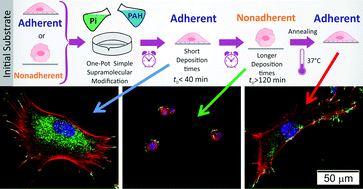当前位置:
X-MOL 学术
›
Biomater. Sci.
›
论文详情
Our official English website, www.x-mol.net, welcomes your feedback! (Note: you will need to create a separate account there.)
Self-assembled phosphate-polyamine networks as biocompatible supramolecular platforms to modulate cell adhesion†
Biomaterials Science ( IF 6.6 ) Pub Date : 2018-06-28 00:00:00 , DOI: 10.1039/c8bm00265g Nicolás E. Muzzio 1, 2, 3, 4 , Miguel A. Pasquale 1, 2, 3, 4 , Waldemar A. Marmisollé 1, 2, 3, 4 , Catalina von Bilderling 1, 2, 3, 4, 5 , M. Lorena Cortez 1, 2, 3, 4 , Lía I. Pietrasanta 6, 7, 8, 9, 10 , Omar Azzaroni 1, 2, 3, 4
Biomaterials Science ( IF 6.6 ) Pub Date : 2018-06-28 00:00:00 , DOI: 10.1039/c8bm00265g Nicolás E. Muzzio 1, 2, 3, 4 , Miguel A. Pasquale 1, 2, 3, 4 , Waldemar A. Marmisollé 1, 2, 3, 4 , Catalina von Bilderling 1, 2, 3, 4, 5 , M. Lorena Cortez 1, 2, 3, 4 , Lía I. Pietrasanta 6, 7, 8, 9, 10 , Omar Azzaroni 1, 2, 3, 4
Affiliation

|
The modulation of cell adhesion via biologically inspired materials plays a key role in the development of realistic platforms to envisage not only mechanistic descriptions of many physiological and pathological processes but also new biointerfacial designs compatible with the requirements of biomedical devices. In this work, we show that the cell adhesion and proliferation of three different cell lines can be easily manipulated by using a novel biologically inspired supramolecular coating generated via dip coating of the working substrates in an aqueous solution of polyallylamine in the presence of phosphate anions—a simple one-step modification procedure. Our results reveal that selective cell adhesion can be controlled by varying the deposition time of the coating. Cell proliferation experiments showed a cell type-dependent quasi-exponential growth demonstrating the nontoxic properties of the supramolecular platform. After reaching a certain surface coverage, the supramolecular films based on phosphate–polyamine networks displayed antiadhesive activity towards cells, irrespective of the cell type. However and most interestingly, these antiadherent substrates developed strong adhesive properties after thermal annealing at 37 °C for 3 days. These results were interpreted based on the changes in the coating hydrophilicity, topography and stiffness, with the latter being assessed by atomic force microscopy imaging and indentation experiments. The reported approach is simple, robust and flexible, and would offer opportunities for the development of tunable, biocompatible interfacial architectures to control cell attachment for various biomedical applications.
中文翻译:

自组装的磷酸盐-多胺网络可作为生物相容性超分子平台来调节细胞粘附†
通过生物学启发的材料对细胞粘附的调节在现实平台的开发中起着关键作用,该现实平台不仅设想许多生理和病理过程的机制描述,而且设想与生物医学设备的要求兼容的新的生物界面设计。在这项工作中,我们表明可以通过使用一种新的生物启发性超分子涂层通过以下方法轻松地操纵三种不同细胞系的细胞粘附和增殖:在磷酸根阴离子的存在下,在聚烯丙胺的水溶液中浸涂工作基材,这是一个简单的一步修饰程序。我们的结果表明,可以通过改变涂层的沉积时间来控制选择性细胞粘附。细胞增殖实验表明,依赖细胞类型的准指数生长证明了超分子平台的无毒特性。达到一定的表面覆盖率后,基于磷酸盐-多胺网络的超分子膜对细胞具有抗粘附活性,而与细胞类型无关。但是,最有趣的是,这些抗粘基材在37°C的温度下退火3天后,表现出很强的粘合性能。这些结果是根据涂层亲水性的变化来解释的,形貌和刚度,后者通过原子力显微镜成像和压痕实验进行评估。报道的方法简单,健壮和灵活,将为开发可调的,生物相容的界面体系结构以控制各种生物医学应用的细胞附着提供机会。
更新日期:2018-06-28
中文翻译:

自组装的磷酸盐-多胺网络可作为生物相容性超分子平台来调节细胞粘附†
通过生物学启发的材料对细胞粘附的调节在现实平台的开发中起着关键作用,该现实平台不仅设想许多生理和病理过程的机制描述,而且设想与生物医学设备的要求兼容的新的生物界面设计。在这项工作中,我们表明可以通过使用一种新的生物启发性超分子涂层通过以下方法轻松地操纵三种不同细胞系的细胞粘附和增殖:在磷酸根阴离子的存在下,在聚烯丙胺的水溶液中浸涂工作基材,这是一个简单的一步修饰程序。我们的结果表明,可以通过改变涂层的沉积时间来控制选择性细胞粘附。细胞增殖实验表明,依赖细胞类型的准指数生长证明了超分子平台的无毒特性。达到一定的表面覆盖率后,基于磷酸盐-多胺网络的超分子膜对细胞具有抗粘附活性,而与细胞类型无关。但是,最有趣的是,这些抗粘基材在37°C的温度下退火3天后,表现出很强的粘合性能。这些结果是根据涂层亲水性的变化来解释的,形貌和刚度,后者通过原子力显微镜成像和压痕实验进行评估。报道的方法简单,健壮和灵活,将为开发可调的,生物相容的界面体系结构以控制各种生物医学应用的细胞附着提供机会。



























 京公网安备 11010802027423号
京公网安备 11010802027423号